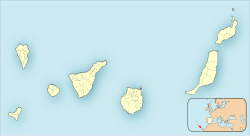Puerto de la Cruz
| Puerto de la Cruz | |||
|---|---|---|---|
| Municipality and city | |||

Puerto de la Cruz, Top left:Panorama view of Puerto de la Cruz, Top right:Martianez Beach, Middle left:Laguna Martianez, Bottom left:Armas Square shopping area, Bottom right:View of Araucaria heterophylla tree in Loro Park
|
|||
|
|||
| Location in Spain | |||
| Coordinates: 28°25′N 16°32′W / 28.417°N 16.533°W | |||
| Country |
|
||
| Autonomous community |
|
||
| Province | Santa Cruz de Tenerife | ||
| Government | |||
| • Mayor | D. Marcos E. Brito Gutiérrez | ||
| Area | |||
| • Total | 8.73 km2 (3.37 sq mi) | ||
| Elevation | 4 m (13 ft) | ||
| Population (2013) | |||
| • Total | 28,929 | ||
| • Density | 3,300/km2 (8,600/sq mi) | ||
| Time zone | GMT (UTC±0) | ||
| • Summer (DST) | UTC+1 (UTC+1) | ||
| Postal code | 38400 | ||
| Official language(s) | Spanish | ||
| Website | Official website | ||
Puerto de la Cruz is a city and municipality in the northern part of the island of Tenerife, Canary Islands, Spain. It was formerly known by its English translation, "Port of the Cross", although now it is known in all languages by its Spanish name. It is located on the north coast, 4 km (2 mi) northwest of La Orotava, and 30 km (19 mi) west of Santa Cruz de Tenerife. The TF-5 motorway passes through the municipality. In Spanish the inhabitants are known as Portuenses. With an area of 8.73 km2 (3 sq mi), the municipality is the smallest in Tenerife.
The population is 28,929 (2013). The elevation of the town centre is 9 m (30 ft) AMSL. The highest point is Las Arenas, a volcanic cone with an elevation of 249 m (817 ft).
Puerto de la Cruz occupies a prominent place in the history of tourism of the islands. The export economy established by the European colonizers after the conquest in the 15th century generated large commercial and passenger movements for decades. The first foreign visitors quickly felt drawn to the beneficial qualities of the weather in the Taoro Valley.
Before mass tourism existed in Puerto de la Cruz, minority tourism catered for privileged elites who were interested in climatology, botany and the tranquility of the location. The proximity of the Canary Islands to Europe meant that travel for health reasons was a primary driver for launching modern tourism here.
At the beginning of the 19th century, the environment of Puerto de la Cruz meant that it attracted many researchers and exclusive high-class groups from Europe. At this stage Puerto de la Cruz was a leading cultural center accommodating many travellers and writers, including William Wilde and Alexander von Humboldt Olivia Stone (Tenerife and its Six Satellites) .
Puerto de la Cruz therefore gained an illustrious reputation in Europe, and when it came to the subsequent advent of modern tourism, the city was at an advantage compared with other tourist sites.
...
Wikipedia



